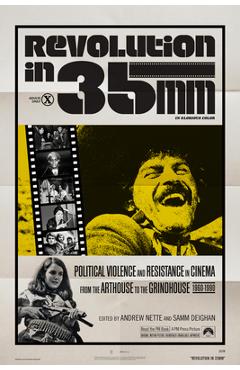Revolution in 35mm: Political Violence and Resistance in Cinema from the Arthouse to the Grindhouse, 1960-1990 - Andrew Nette

Detalii Revolution in 35mm: Political Violence
libris.ro
177.42 Lei
197.13 Lei
Performing Arts
Andrew Nette
Revolution in 35mm: Political Violence - Disponibil la libris.ro
Pe YEO găsești Revolution in 35mm: Political Violence de la Andrew Nette, în categoria Performing Arts.
Indiferent de nevoile tale, Revolution in 35mm: Political Violence and Resistance in Cinema from the Arthouse to the Grindhouse, 1960-1990 - Andrew Nette din categoria Performing Arts îți poate aduce un echilibru perfect între calitate și preț, cu avantaje practice și moderne.
Preț: 177.42 Lei
Caracteristicile produsului Revolution in 35mm: Political Violence
- Brand: Andrew Nette
- Categoria: Performing Arts
- Magazin: libris.ro
- Ultima actualizare: 28-10-2025 01:22:05
Comandă Revolution in 35mm: Political Violence Online, Simplu și Rapid
Prin intermediul platformei YEO, poți comanda Revolution in 35mm: Political Violence de la libris.ro rapid și în siguranță. Bucură-te de o experiență de cumpărături online optimizată și descoperă cele mai bune oferte actualizate constant.
Descriere magazin:
Revolution in 35mm: Political Violence and Resistance in Cinema from the Arthouse to the Grindhouse, 1960-1990 examines how political violence and resistance was represented in arthouse and cult films from 1960 to 1990. This historical period spans the Algerian war of independence and the early wave of post-colonial struggles that reshaped the Global South, through the collapse of Soviet Communism in the late \'80s. It focuses on films related to the rise of protest movements by students, workers, and leftist groups, as well as broader countercultural movements, Black Power, the rise of feminism, and so on. The book also includes films that explore the splinter groups that engaged in violent, urban guerrilla struggles throughout the 1970s and 1980s, as the promise of widespread radical social transformation failed to materialize: the Weathermen, the Black Liberation Army and the Symbionese Liberation Army in the United States, the Red Army Faction in West Germany and Japan, and Italy\'s Red Brigades. Many of these movements were deeply connected with and expressed their values through art, literature, popular culture, and, of course, cinema. Twelve authors, including academics and well know film critics, deliver a diverse examination of how filmmakers around the world reacted to the political violence and resistance movements of the period and how this was expressed on screen. This includes looking at the financing, distribution, and screening of these films, audience and critical reaction, the attempted censorship or suppression of much of this work, and how directors and producers eluded these restrictions. Including over two hundred illustrations, the book examines filmmaking movements like the French, Japanese, German, and Yugoslavian New Waves; subgenres like spaghetti westerns, Italian poliziotteschi, Blaxploitation, and mondo movies; and films that reflect the values of specific movements like feminists, Vietnam War protesters, and Black militants. The work of influential and well-known political filmmakers such as Costa-Gavras, Gillo Pontecorvo, and Glauber Rocha is examined side by side with grindhouse cinema and lessor known titles by a host of all-but forgotten filmmakers, including many from the Global South, that are deserving of rediscovery.

Produse asemănătoare

Revolution in 35mm: Political Violence and Resistance in Cinema from the Arthouse to the Grindhouse, 1960-1990 - Andrew Nette
![]() libris.ro
libris.ro
Actualizat in 28/10/2025
177.42 Lei

Revolution in 35mm. Political Violence and Resistance in Cinema from the Arthouse to the Grindhouse, 1969-1990, Paperback/***
![]() elefant.ro
elefant.ro
Actualizat in 27/10/2025
209.99 Lei
Produse marca Andrew Nette

Revolution in 35mm: Political Violence and Resistance in Cinema from the Arthouse to the Grindhouse, 1960-1990 - Andrew Nette
![]() libris.ro
libris.ro
Actualizat in 28/10/2025
177.42 Lei